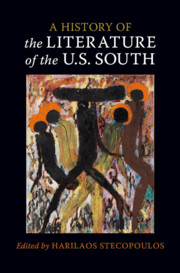Book contents
- A History of the Literature of the U.S. South
- A History of the Literature of the U.S. South
- Copyright page
- Contents
- Contributors
- Acknowledgements
- Introduction
- Chapter 1 Fictions of the Native South
- Chapter 2 John Smith and the English Origins of Southern Exceptionalism
- Chapter 3 Plantation and Enlightenment
- Chapter 4 Geoconfederacy
- Chapter 5 In the Shadow of His Office
- Chapter 6 Shadows of Haiti
- Chapter 7 “Midnight Bakings” Amid Starvation
- Chapter 8 A Calculated Fiction
- Chapter 9 Maroons and Marronage in Antebellum African American Literature
- Chapter 10 Everyday Literary Culture in the Nineteenth Century
- Chapter 11 Fables of the Bloody Shirt
- Chapter 12 A Heritage Unique in the Ages
- Chapter 13 Moonlight and Magnolias No More
- Chapter 14 Women Writers and the Southern Renaissance; or, the Work of Gender in Literary Periodization
- Chapter 15 Southern Geographies and New Negro Modernism
- Chapter 16 “A fine loud grabble and snatch of AAA and WPA”
- Chapter 17 Provincialism as a Positive Good
- Chapter 18 Faulkner’s Untimely Fiction
- Chapter 19 Reconsidering Du Bois’s “Central Text”
- Chapter 20 Cultural Activism and Theater of the Civil Rights Movement
- Chapter 21 Till the Hurt Becomes Music
- Chapter 22 Undead Sound
- Chapter 23 There Is No South
- Chapter 24 Hurricane Alley
- Select Bibliography
- Index
Chapter 11 - Fables of the Bloody Shirt
Reconstruction and the Problem of National Violence
Published online by Cambridge University Press: 29 April 2021
- A History of the Literature of the U.S. South
- A History of the Literature of the U.S. South
- Copyright page
- Contents
- Contributors
- Acknowledgements
- Introduction
- Chapter 1 Fictions of the Native South
- Chapter 2 John Smith and the English Origins of Southern Exceptionalism
- Chapter 3 Plantation and Enlightenment
- Chapter 4 Geoconfederacy
- Chapter 5 In the Shadow of His Office
- Chapter 6 Shadows of Haiti
- Chapter 7 “Midnight Bakings” Amid Starvation
- Chapter 8 A Calculated Fiction
- Chapter 9 Maroons and Marronage in Antebellum African American Literature
- Chapter 10 Everyday Literary Culture in the Nineteenth Century
- Chapter 11 Fables of the Bloody Shirt
- Chapter 12 A Heritage Unique in the Ages
- Chapter 13 Moonlight and Magnolias No More
- Chapter 14 Women Writers and the Southern Renaissance; or, the Work of Gender in Literary Periodization
- Chapter 15 Southern Geographies and New Negro Modernism
- Chapter 16 “A fine loud grabble and snatch of AAA and WPA”
- Chapter 17 Provincialism as a Positive Good
- Chapter 18 Faulkner’s Untimely Fiction
- Chapter 19 Reconsidering Du Bois’s “Central Text”
- Chapter 20 Cultural Activism and Theater of the Civil Rights Movement
- Chapter 21 Till the Hurt Becomes Music
- Chapter 22 Undead Sound
- Chapter 23 There Is No South
- Chapter 24 Hurricane Alley
- Select Bibliography
- Index
Summary
The political violence of Reconstruction, especially as directed at African Americans, initially occasioned national alarm and federal intervention.As Reconstruction progressed, however, literary tactics emerged that rendered acts of terror as discrete and disorganized, and thus as posing no threat to the nation state. Eventually dominating the domain of genteel print, literary and journalistic narratives adopted a number of strategies that rendered racial violence routine and even normative, portraying white southerners as besieged victims of the Reconstruction government forced to resort to violence in order to protect Anglo-Saxon prerogatives.Although the rhetoric of the “bloody shirt,” along with literary interventions by Mark Twain and Albion Tourgée, sought to foreground the continued threat of racial violence to the nation state and its citizens, this ascendant narrative increasingly controlled the “facts” of Reconstruction.By the early twentieth century, historians and novelists had consolidated the lessons of Reconstruction in ways conducive to an expansionist white nationalism.
- Type
- Chapter
- Information
- A History of the Literature of the U.S. South , pp. 185 - 202Publisher: Cambridge University PressPrint publication year: 2021

